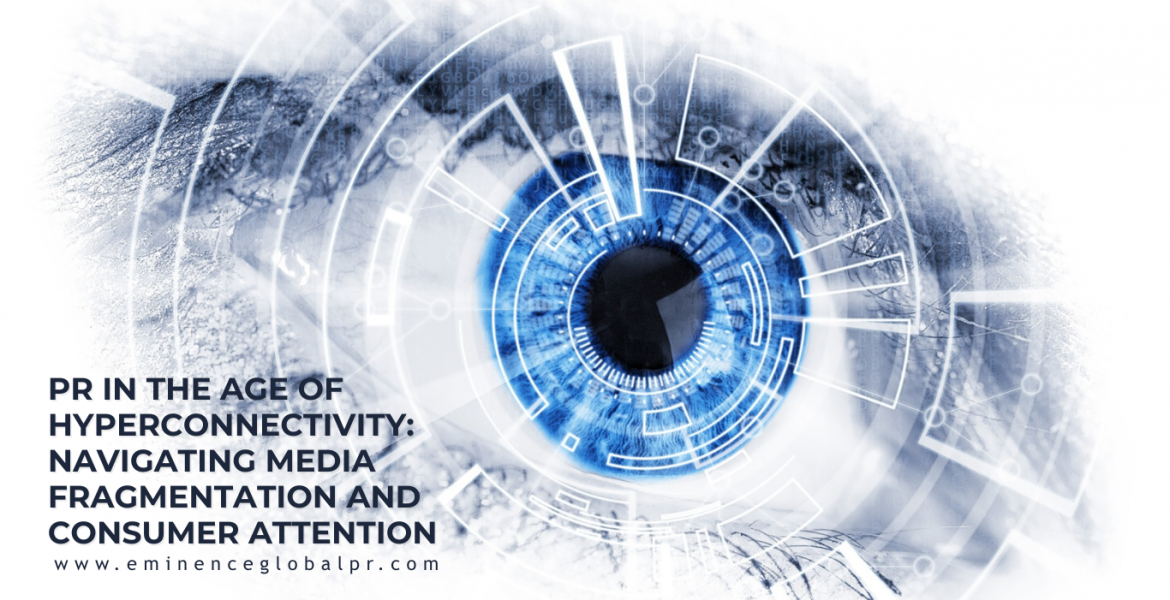
The dawn of the digital age has brought about unprecedented levels of hyperconnectivity, altering how brands engage with their audiences. In this new epoch, where media is more fragmented than ever before, PR Firms face significant challenges in capturing and maintaining consumer attention. The proliferation of platforms, the rise of digital-first content, and the evolution of consumer behaviors present a complex environment for PR strategists to navigate. This report delves into the intricacies of this hyperconnected media landscape, exploring how brands can adapt to media fragmentation and offering strategies for maintaining consumer engagement in an increasingly dispersed digital ecosystem.
The fragmentation of media channels, combined with the rapidly evolving nature of consumer attention, demands a recalibration of traditional PR practices. While the landscape continues to expand, PR firms must pivot their approaches to ensure that communication remains relevant, timely, and impactful. By leveraging innovative technologies, data-driven insights, and an acute understanding of consumer psychology, PR firms can not only survive but thrive in this era of hyperconnectivity.
Introduction: The Era of Hyperconnectivity
Hyperconnectivity refers to the state where individuals and devices are constantly interconnected, enabled by mobile devices, social media, and a plethora of digital platforms. In 2025, the global average internet penetration stands at over 60%, with billions of active users across multiple devices. Consequently, the sheer volume of information and communication channels has created a fragmented media ecosystem where consumers’ attention is more divided than ever.
This fragmentation has profound implications for PR strategies. As traditional media channels (television, radio, and print) cede ground to digital-first platforms such as social media, podcasts, video streaming, and niche online publications, brands are required to engage consumers in a more personalized, diversified manner. For firms, the challenge lies not only in adapting to this change but also in crafting strategies that can engage, influence, and retain an audience across multiple touchpoints.
I. The Fragmented Media Landscape
1. Evolution of Media Channels
The PR industry’s historical reliance on a relatively small number of media outlets newspapers, TV, and radio has been replaced by an explosion of digital channels. Social media platforms like Facebook, Instagram, Twitter, and TikTok, along with messaging apps like WhatsApp and Telegram, have become the dominant spaces for content consumption.
Furthermore, the growing prominence of digital-first platforms like podcasts, YouTube, and even live-streamed events has further fragmented the media landscape. This has created a reality where consumers can engage with content in a way that suits their preferences, at any time and from anywhere. As such, PR agencies must now tailor their messages for a multitude of different formats, contexts, and audiences.
Key Implications
- Platform Specialization – Each platform offers a distinct user experience, demographic, and communication style. PR firms must adapt their messaging and content to fit the platform in question, ensuring relevance and maximizing engagement.
- Rise of Micro-Influencers – The proliferation of social media has led to the rise of micro-influencers individuals with smaller but highly engaged audiences. These influencers offer unique opportunities for brands to reach niche communities with targeted messaging.
2. Consumer Attention: The New Currency
In the age of hyperconnectivity, consumer attention has become the most coveted resource for brands. With endless content vying for a consumer’s attention, it is increasingly difficult to maintain meaningful engagement. Studies indicate that the average human attention span has dropped to just 8 seconds, a stark contrast to 12 seconds in 2000. Consumers are constantly bombarded with information, making it crucial for PR firms to craft highly compelling, brief, and engaging content that stands out in the noise.
Key Implications
- Information Overload: The sheer volume of content available across different channels means consumers are increasingly selective about the media they consume. This requires PR firms to be strategic in how and when they deliver messages.
- Personalization: To capture and retain consumer attention, PR strategies must focus on personalization. By tailoring messages to individual preferences, interests, and behaviors, brands can enhance relevance and increase engagement.
II. Strategies for Navigating Media Fragmentation and Capturing Consumer Attention
1. Omnichannel PR Strategies: Unifying the Dispersed Media
In a fragmented media landscape, an omnichannel approach is paramount. An omnichannel PR strategy involves coordinating messaging across multiple platforms and touchpoints, ensuring that the brand’s narrative remains consistent while being tailored to each medium’s unique requirements.
Key Tactics
- Platform-Specific Content – Each platform whether it’s TikTok’s short-form video, Instagram’s visual-centric content, or Twitter’s brief and timely posts requires a distinct type of content. PR professionals must craft content that resonates with the platform’s

audience while maintaining brand consistency across channels.
- Cross-Platform Campaigns – Coordinating campaigns across multiple platforms ensures that the message reaches the audience wherever they are. This requires PR professionals to craft messages that can be adapted without losing their core message.
2. Leveraging Data and Analytics for Audience Insights
The explosion of digital content has also made data analytics indispensable in PR. By leveraging big data and artificial intelligence (AI), PR firms can better understand audience behavior, preferences, and pain points. This data-driven approach allows brands to deliver more relevant content, track engagement metrics in real-time, and adjust campaigns dynamically to maintain consumer attention.
Key Tactics
- Real-Time Social Listening – Monitoring social media conversations enables PR firms to stay ahead of trending topics, consumer sentiment, and emerging issues. By leveraging social listening tools, brands can engage in real-time, positioning themselves as relevant and responsive.
- Audience Segmentation – Using data to segment audiences into distinct groups based on demographics, psychographics, and behavior enables PR firms to create personalized content that resonates with each segment.
3. Storytelling in the Digital Age: Crafting Content that Connects
Storytelling remains one of the most powerful tools in a PR firms’ arsenal. However, the storytelling approach must evolve to accommodate the new media environment. Content must be not only engaging but also authentic and relatable. Consumers are increasingly looking for transparency and value, and they demand more from the brands they engage with.
Key Tactics
- Interactive Content – Consumers now expect interactive and immersive experiences. Using augmented reality (AR), virtual reality (VR), or gamified content can provide consumers with an engaging way to interact with a brand’s story.
- Authenticity and Transparency: Consumers, particularly younger generations, are more likely to trust brands that are open about their values and business practices. PR firms must ensure that storytelling is not only compelling but also honest and socially responsible.
4. Influence of Micro-Influencers and User-Generated Content (UGC)
The rise of micro-influencers has fundamentally altered the PR landscape. Micro-influencers are often viewed as more authentic and relatable than traditional celebrities, making them ideal partners for PR campaigns aimed at building trust and engagement.
 Key Tactics
Key Tactics
- Collaborating with Micro-Influencers – PR firms can amplify their reach by collaborating with micro-influencers who have highly engaged, niche followings. These influencers can serve as authentic brand advocates, driving more targeted, impactful conversations.
- Encouraging User-Generated Content (UGC) – By encouraging consumers to create content on behalf of the brand, PR firms can create a sense of community and social proof. UGC provides valuable social currency and can be a highly effective means of sustaining consumer attention.
5. Real-Time Crisis Management and Agile Communication
The hyperconnected world means that news travels faster than ever, and a brand’s reputation can be damaged in an instant. Effective crisis management requires real-time monitoring, quick response times, and agility. PR firms must be prepared to react to emerging issues, pivoting communication strategies to maintain brand credibility.
Key Tactics
- 24/7 Monitoring – PR professionals must have systems in place to monitor news, social media, and online sentiment continuously, enabling them to identify potential issues before they escalate.
- Crisis Communication Plans – Developing a robust crisis communication plan that is flexible and adaptable to various scenarios ensures that brands can respond swiftly and effectively when issues arise.
III. Conclusion: The Future of PR in the Age of Hyperconnectivity
The media landscape in 2025 is defined by fragmentation, where multiple platforms, diverse content formats, and shifting consumer behaviors have fundamentally changed how PR firms must approach their craft. In this environment, success hinges on adaptability, agility, and a deep understanding of both the platforms and the consumers that engage with them.
By embracing omnichannel strategies, harnessing data and analytics, crafting authentic narratives, and leveraging emerging technologies, PR firms can navigate this fragmented media environment and capture the elusive commodity of consumer attention. The PR profession must evolve beyond traditional methods, incorporating digital innovation and creative content solutions that resonate with an increasingly hyperconnected audience. In doing so, brands can ensure their voice is heard, their narrative is compelling, and their reputation is resilient in the face of the ever-expanding digital ecosystem.
